The call of the wild often leads us down unexpected paths. Sometimes, grand plans for distant peaks shift closer to home, revealing hidden gems. This is precisely how I discovered the Manistee River Trail loop, a truly rewarding experience when backpacking in Manistee National Forest, Michigan. Nestled in the northern part of the state, this national forest offers a vibrant tapestry of landscapes, from deep pine forests and deciduous stands bursting with color to the gentle meanderings of the Manistee River. While less imposing than the Rockies, the trails here offer a unique blend of accessible beauty, natural serenity, and a perfect introduction (or return) to the joys of multi-day hiking.
Why Choose Manistee National Forest for Backpacking?
Manistee National Forest, part of the larger Huron-Manistee National Forests, is a haven for outdoor enthusiasts. Its varied terrain, network of trails, and abundant waterways provide diverse recreational opportunities. For backpackers, the Manistee River Trail (MRT) and its connection to the North Country Trail (NCT) form a popular and well-maintained loop that showcases the best of the region’s natural beauty. It’s challenging enough to feel like an accomplishment but manageable for hikers with some experience, making it an ideal destination for backpacking in Manistee National Forest.
Planning Your Backpacking Trip
A successful backpacking trip begins with thorough planning. The Manistee River Trail/North Country Trail loop is a relatively straightforward route, but understanding the details before you go will enhance your experience.
Trail Overview & Stats
The loop is approximately 19.1 miles (30.7 km) with a total elevation gain/loss around 2540 feet (774 meters). It’s typically completed as a 2-day, 1-night trip, though extending it to 3 days for a more leisurely pace is certainly an option. The difficulty is generally considered Class 1, suitable for most hikers capable of covering the mileage.
Getting There & Access Points
The loop is located near Luther, Michigan. Multiple access points make starting the trip convenient. Common parking areas include Red Bridge, Cottage Road, and South Slagle Creek Road. Seaton Creek Campground also offers parking (for a small fee), which includes access to potable water when the spigot is active.
Permits, Regulations, and Leave No Trace
One of the appeals of backpacking in Manistee National Forest is the relative lack of stringent regulations compared to some other public lands. A permit is not required for hiking or overnight backpacking on this loop. Dispersed camping is allowed along both the MRT and NCT, provided you follow standard dispersed camping practices (camp 100-200 feet from water and trails, minimize impact). Additionally, there are established, free, first-come, first-served campsites specifically along the Manistee River Trail. Parking is generally free at most trailheads, except for Seaton Creek Campground. As with all outdoor adventures, adhering strictly to the Leave No Trace principles is paramount to preserving the beauty and integrity of this forest for future visitors.
Essential Resources
While the trail is well-marked, having a reliable map is crucial. Michigan Trail Maps offers a useful printed map detailing mileages, campsites, and points of interest. The National Forest website for the Huron-Manistee National Forests also provides valuable information regarding conditions, regulations, and access.
Experiencing the Trail: A Backpacking Journey
My own adventure backpacking in Manistee National Forest unfolded over a cool October weekend, a time when the forest truly shines with autumnal glory.
Day 1: Arrival and the Manistee River Trail
After a longer-than-planned drive north into Michigan, my friends Emily, Kenza, and I were eager to finally hit the trail. The air was crisp, the leaves were just beginning their fiery transformation, and the conditions felt perfect for backpacking. We started from the Cottage Road parking area, located roughly at mile 7.8 of the Manistee River Trail.
Kenza, Emily, and I ready for a relaxing weekend of backpacking.
The trail initially ducks into a tunnel of young trees before opening up into a more mature pine forest. The ground was a carpet of fallen leaves – reds, yellows, and browns – adding a vibrant touch to the undergrowth. Sunlight filtered through the canopy, creating shifting patterns on the path. We passed several occupied campsites, many offering lovely views of the river. The number of people out wasn’t surprising, given the fantastic weather forecast.
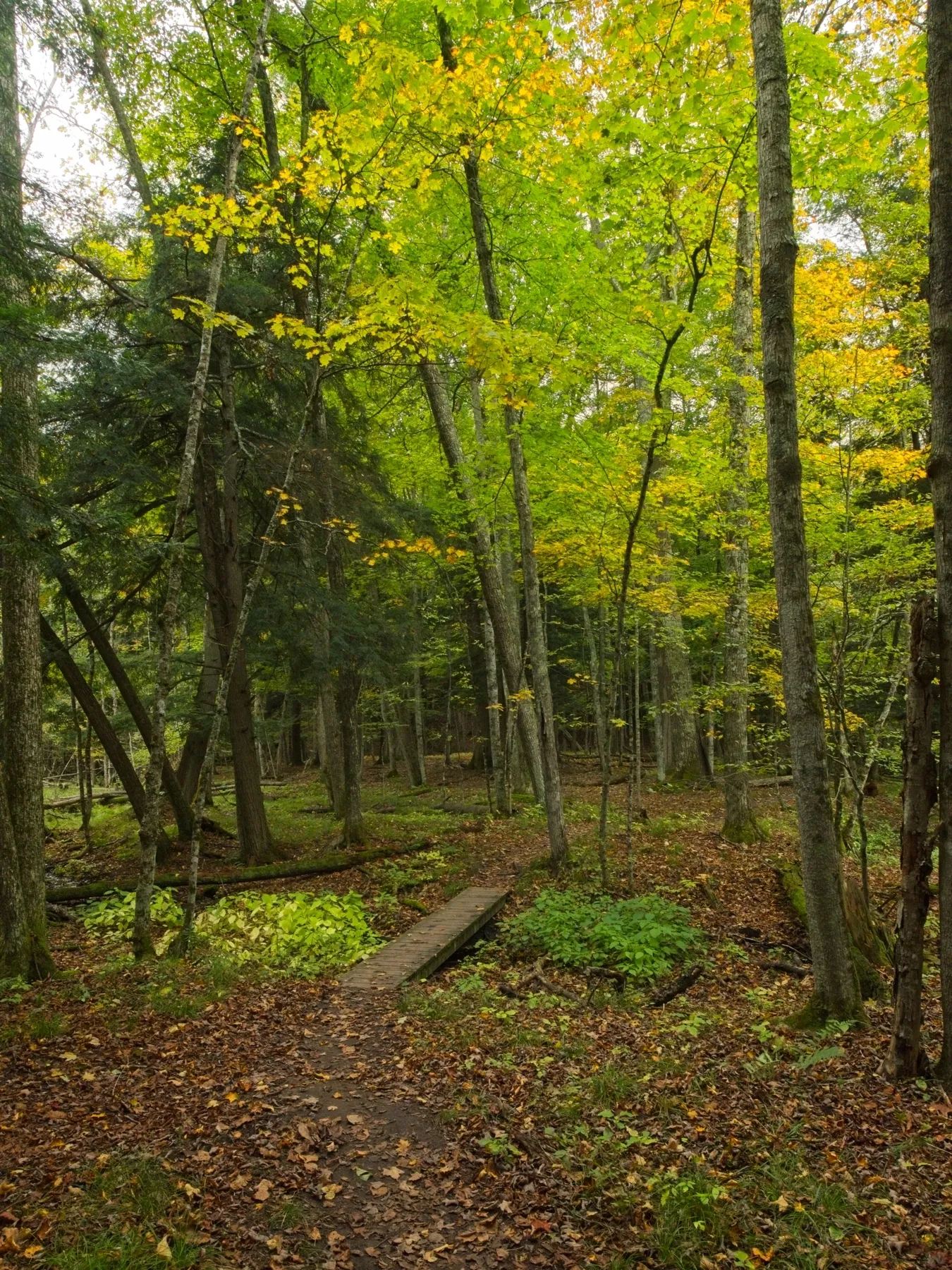 A footbridge crossing a small creek on the Manistee River TrailBetween some gentle ups and downs, we tread through the forest and over small creeks
A footbridge crossing a small creek on the Manistee River TrailBetween some gentle ups and downs, we tread through the forest and over small creeks
We continued our walk, the trail winding through riverside marshes, transitioning back into dark forests, and occasionally ascending onto open ridges. With only a few hours of daylight left, finding a campsite was our priority. We passed several occupied spots before happily snagging site 10b, the last available established site we encountered. Marked clearly, it offered ample space and, crucially, a superb view overlooking the river and the surrounding colorful trees. As we set up camp, a light drizzle began, prompting us to pull on our rain gear before settling in for dinner.
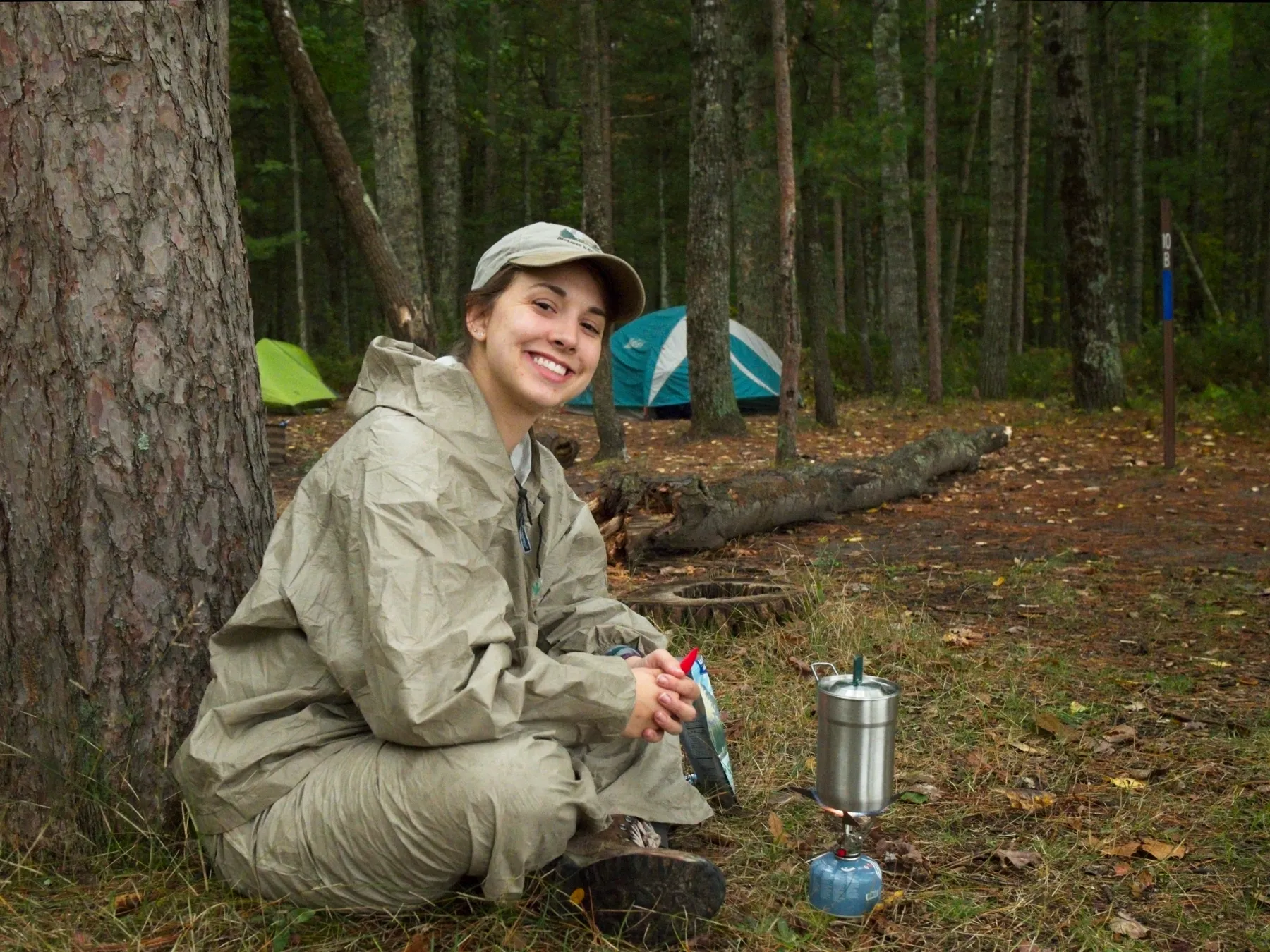 Hiker heating water for a meal at a campsiteEmily heats water for dinner, a classic backpacking routine.
Hiker heating water for a meal at a campsiteEmily heats water for dinner, a classic backpacking routine.
Kenza enjoys a simple, no-cook PB&J bagel for dinner after the hike.
The drizzle persisted into the evening, eventually sending us into the dry comfort of our tents.
Our two small tents fit comfortably in the spacious site 10b.
Day 2: Ascending to the North Country Trail
Waking up on the second morning was a delight – the rain had passed, and the sun was beginning to peek over the horizon. From campsite 10b, we were treated to a spectacular light show as the sky over the river valley shifted from purple to pink. It was a perfect start to another day of backpacking in Manistee National Forest.
A colorful sunrise paints the sky over the river valley from campsite 10b.
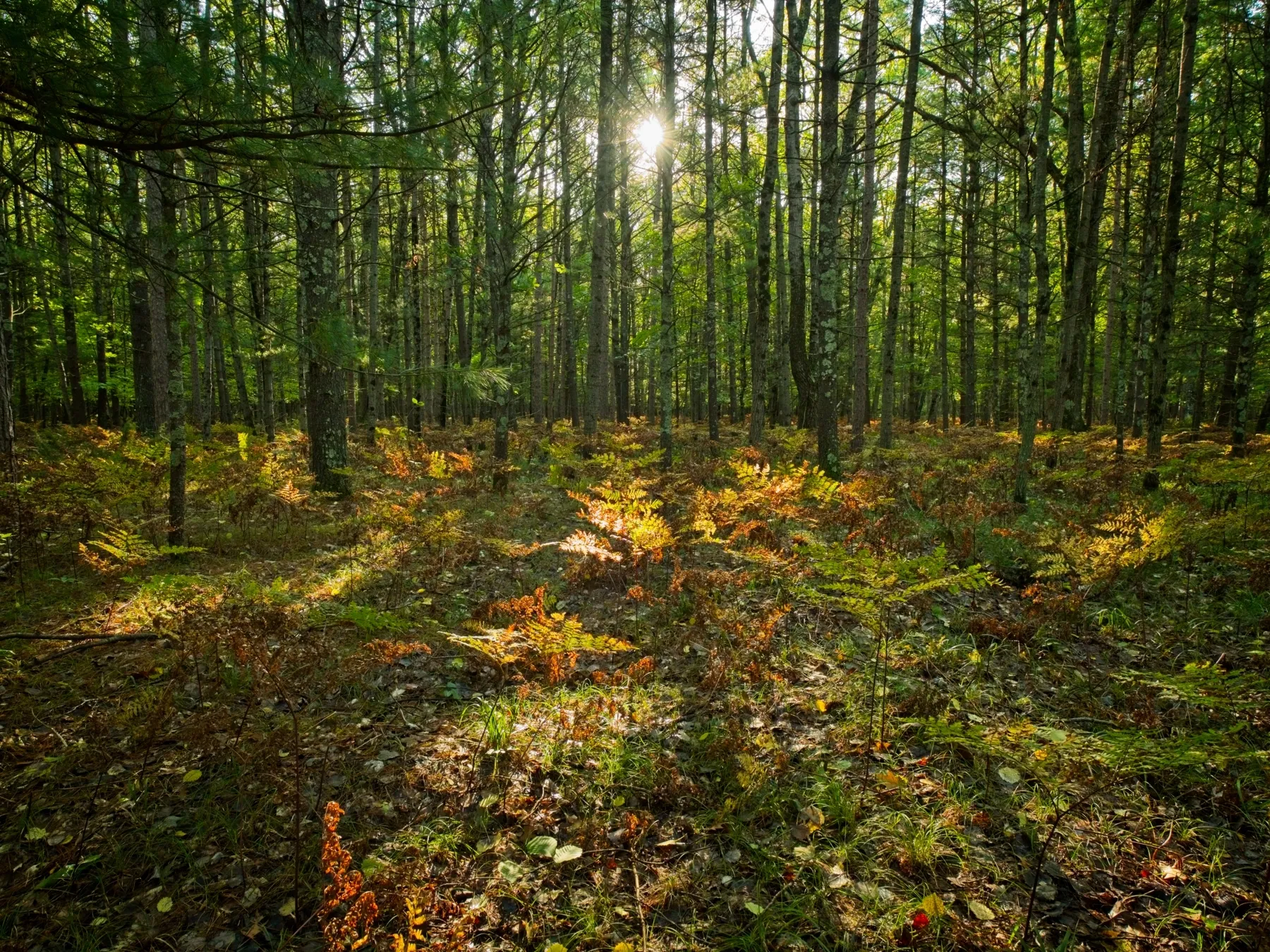 Morning sunlight filtering through the trees on the trailThe promise of dryer weather is evident as morning sunlight filters through the forest.
Morning sunlight filtering through the trees on the trailThe promise of dryer weather is evident as morning sunlight filters through the forest.
After breakfast, we packed up and hiked the short distance to the Red Bridge. Interestingly, despite its name, the bridge itself isn’t red. This was our last reliable water source for approximately 10 miles, so we took the time to filter water from the river, filling all our bottles. (Note: In summer, a spigot at the nearby campground might offer potable water, but it was shut off for the season during our fall visit).
Emily efficiently filters water from the Manistee River.
Kenza purifies the river water with ultraviolet radiation.
Water secured, we shouldered our packs and began the ascent (including a few steep hills!) to connect with the North Country Trail (NCT). The NCT is an epic trail stretching over 4,600 miles across multiple states, though still under development in places. Our segment was much shorter, following the NCT northbound for about eight miles. The terrain here contrasts significantly with the MRT; the NCT generally winds along a forested ridge, often out of sight of the river, and features more noticeable elevation changes than the relatively flat MRT.
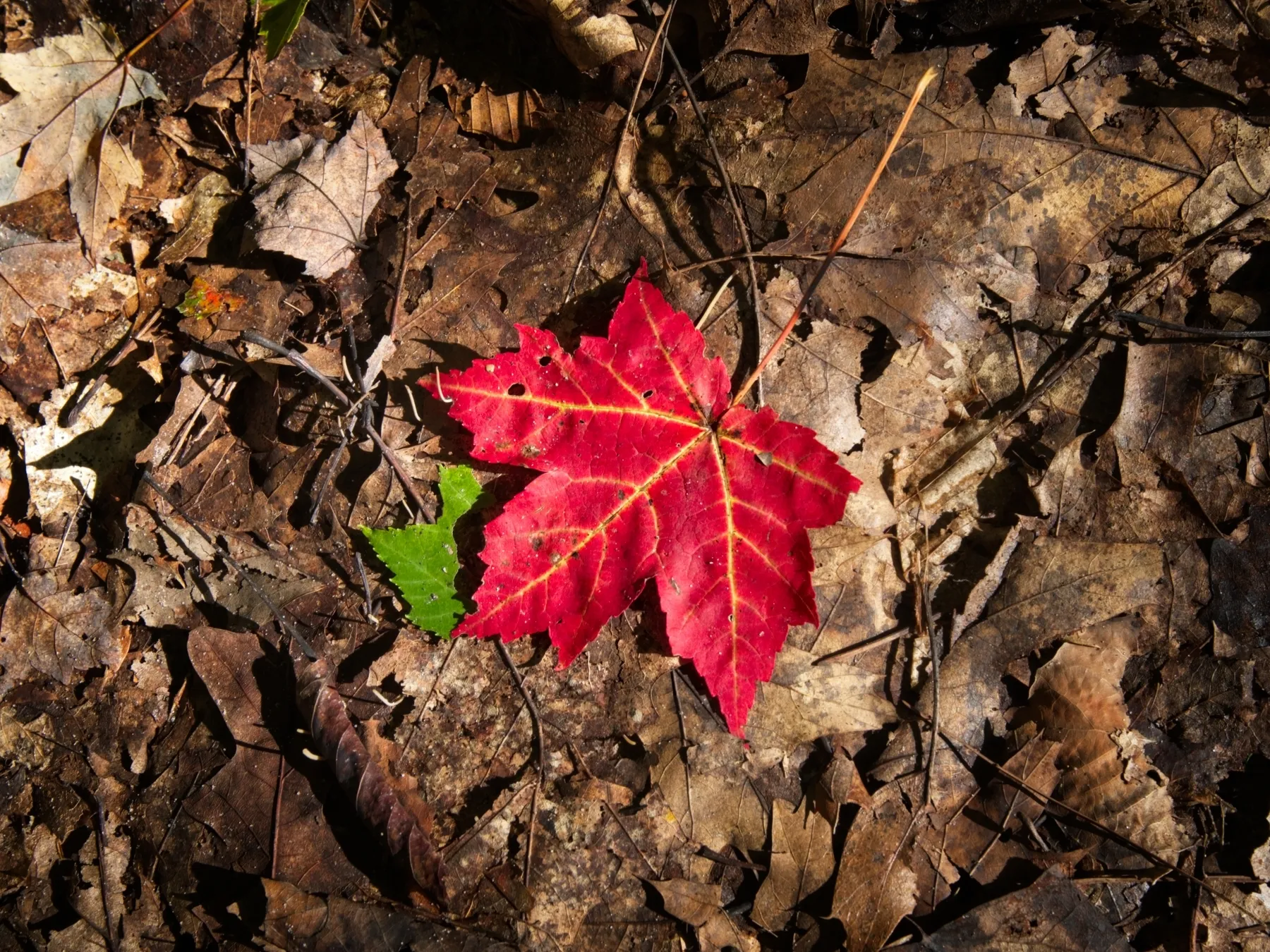 A vibrant orange maple leaf on the forest floorOne of the many colorful leaves adorning the trail in autumn.
A vibrant orange maple leaf on the forest floorOne of the many colorful leaves adorning the trail in autumn.
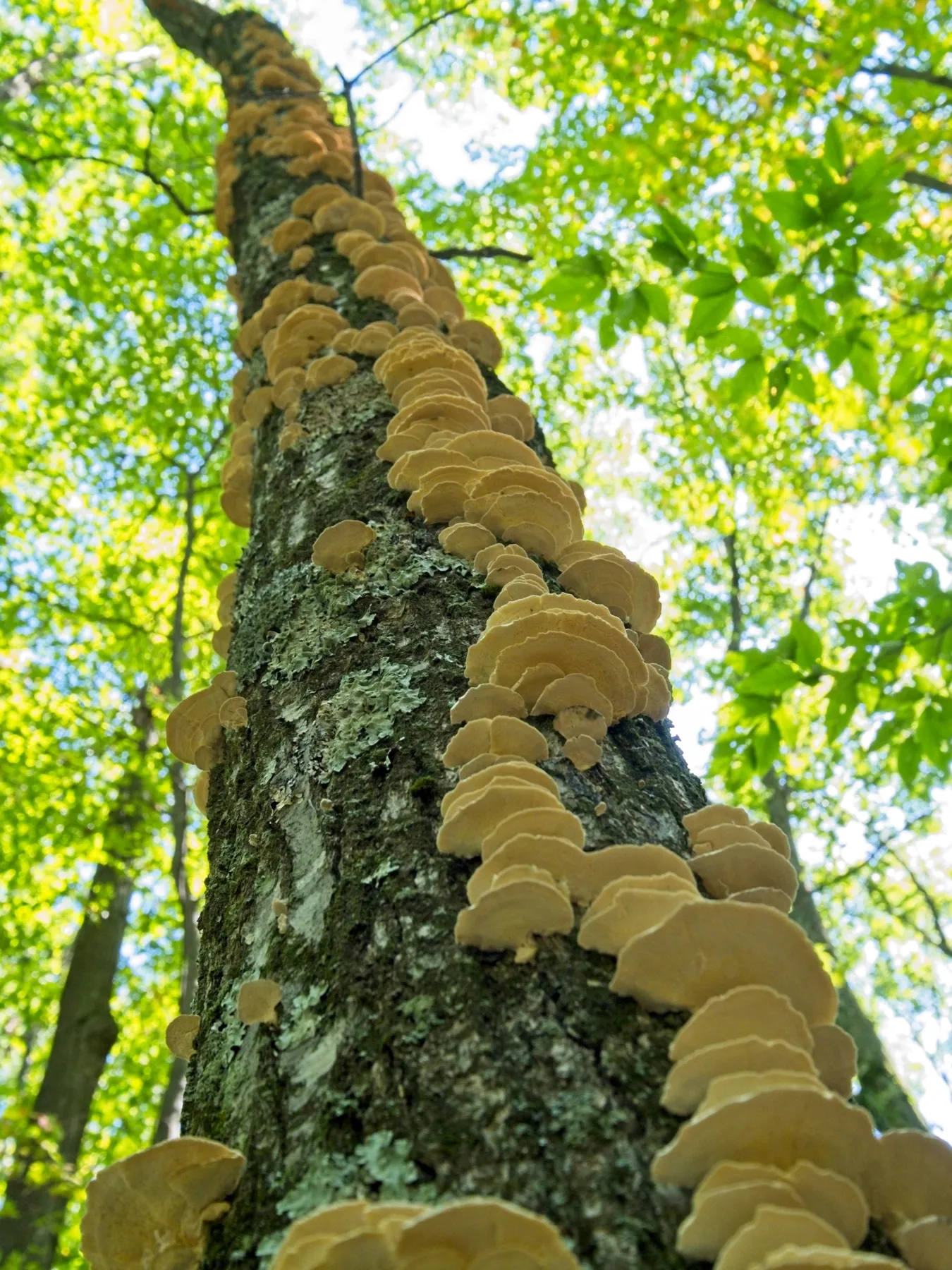 Shelf fungi growing on the side of a treeShelf fungi add interesting texture to the trees along the path.
Shelf fungi growing on the side of a treeShelf fungi add interesting texture to the trees along the path.
We enjoyed a leisurely pace through the woods. Around noon, we stopped at Red Hill, one of the higher points on this section, hoping for expansive views during lunch. The outlook proved a bit underwhelming, but it served as a perfectly good spot to rest and refuel. The walk continued through pleasant forest, with dappled sunlight breaking through the canopy and colorful leaves scattered everywhere. Despite the near-perfect weather, we encountered very few other people on the NCT segment, just a couple of mountain bikers.
The North Country Trail segment features longer ups and downs but remains very manageable.
Silver birch trees provide a striking contrast within the mixed forest.
In the early evening, we found a suitable dispersed campsite on a small ridge above Eddington Creek and decided to make camp for the night. We set up our tents, which were still slightly damp from the previous night’s rain, and built a campfire. The warmth from the fire was very welcome as the sun began to set and temperatures dropped. After dinner, we relaxed by the fire, sipping tea and enjoying the quiet evening.
Emily constructing a campfire at our second night’s campsite.
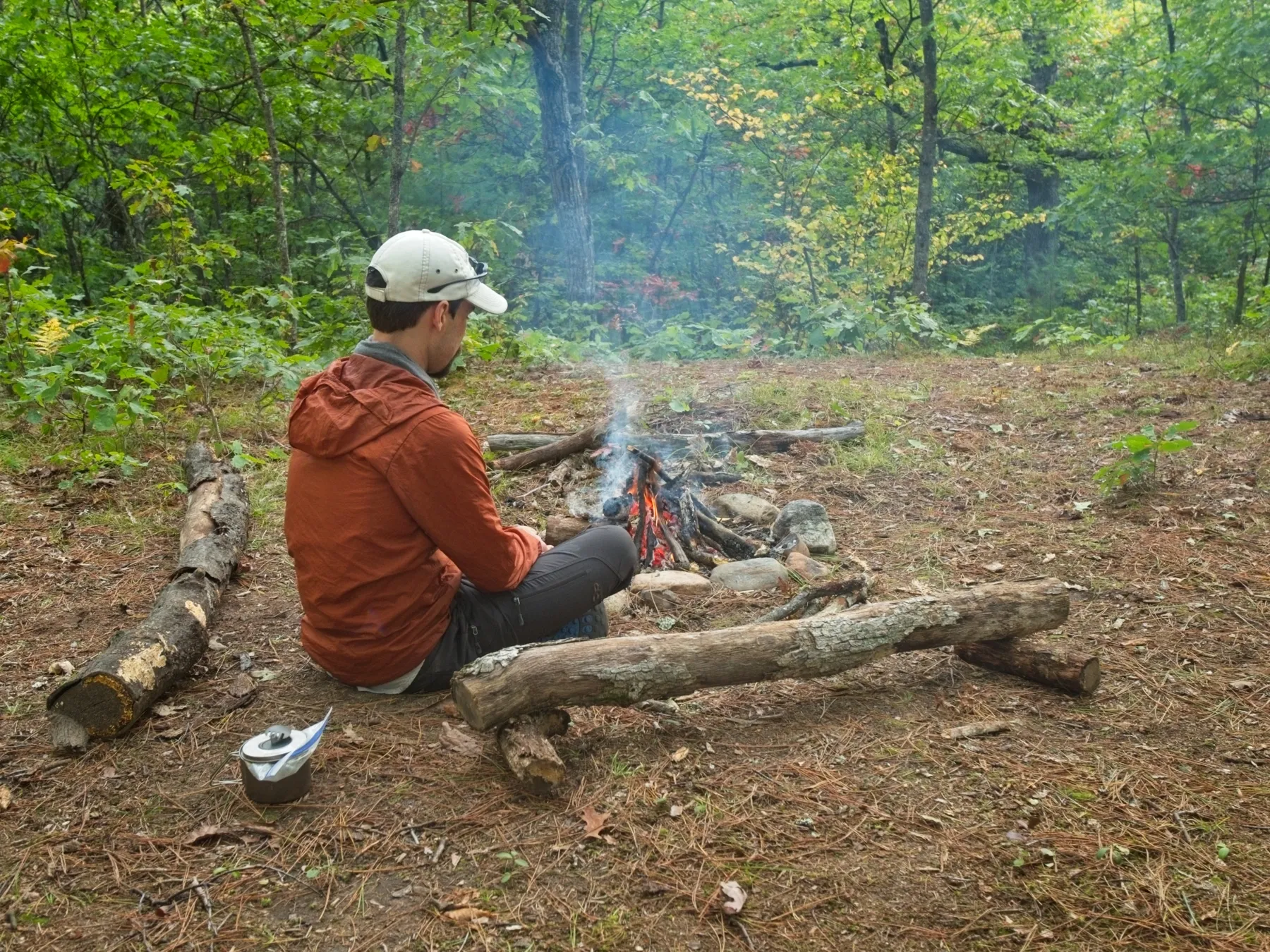 Hiker looking into the flames of a campfireWaiting patiently for rehydrated dinner by the warm fire.
Hiker looking into the flames of a campfireWaiting patiently for rehydrated dinner by the warm fire.
Emily and Kenza relaxing beside the campfire with cups of tea.
Day 3: The Scenic Return via the MRT
The final morning dawned bright and cool, another ideal day for backpacking. The initial section of our hike followed an old railroad grade, making for an easy, flat walk. About a mile from our campsite, we turned onto a spur trail that led back towards the river and, excitingly, a suspension footbridge! Crossing the bridge provided a scenic connection back to the Manistee River Trail.
Another sunny day with beautiful dappled light on the trail.
 Hiker walking on an old railroad grade trailWalking along an old railroad grade makes for an easy morning hike.
Hiker walking on an old railroad grade trailWalking along an old railroad grade makes for an easy morning hike.
Indeed, walking alongside the river on the MRT section was significantly more scenic than the ridge-bound NCT. Honestly, for pure visual enjoyment, hiking the Manistee River Trail as an out-and-back might even be preferable to completing the full loop, though the loop offers a good variety of terrain.
Soon after rejoining the Manistee River Trail, we reached the awesome view of Horseshoe Bend.
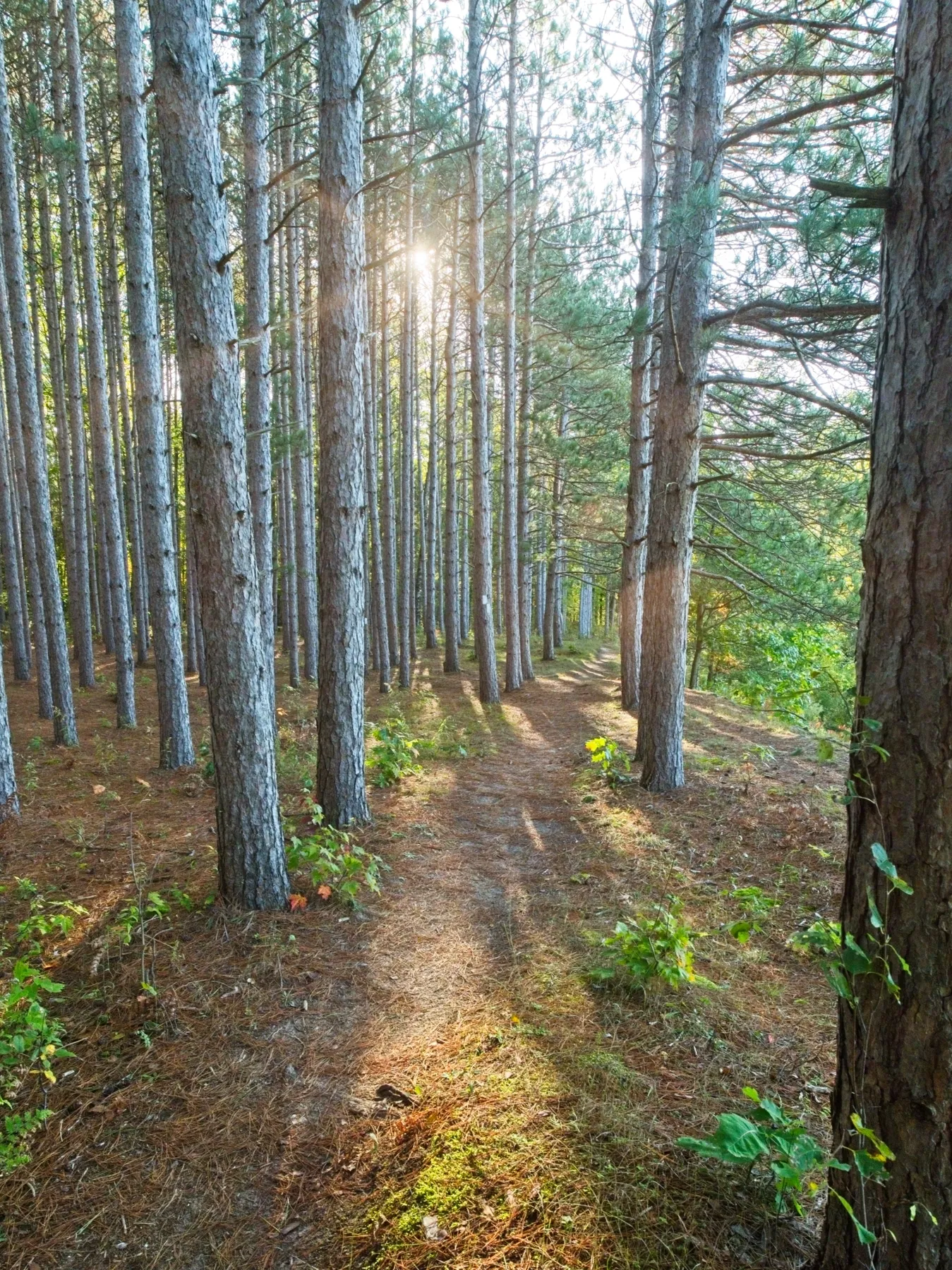 The Manistee River Trail winding through tall pines beside the riverThe MRT threads through tall pines right beside the Manistee River.
The Manistee River Trail winding through tall pines beside the riverThe MRT threads through tall pines right beside the Manistee River.
A short distance further, we passed what is marked as a “waterfall” on the map. Reportedly discovered only in 1990 (a relatively recent discovery for the Lower Peninsula!), its total drop was perhaps only five feet. It was an interesting feature but certainly not a dramatic cascade; perhaps it’s more impressive with higher water flow in the springtime.
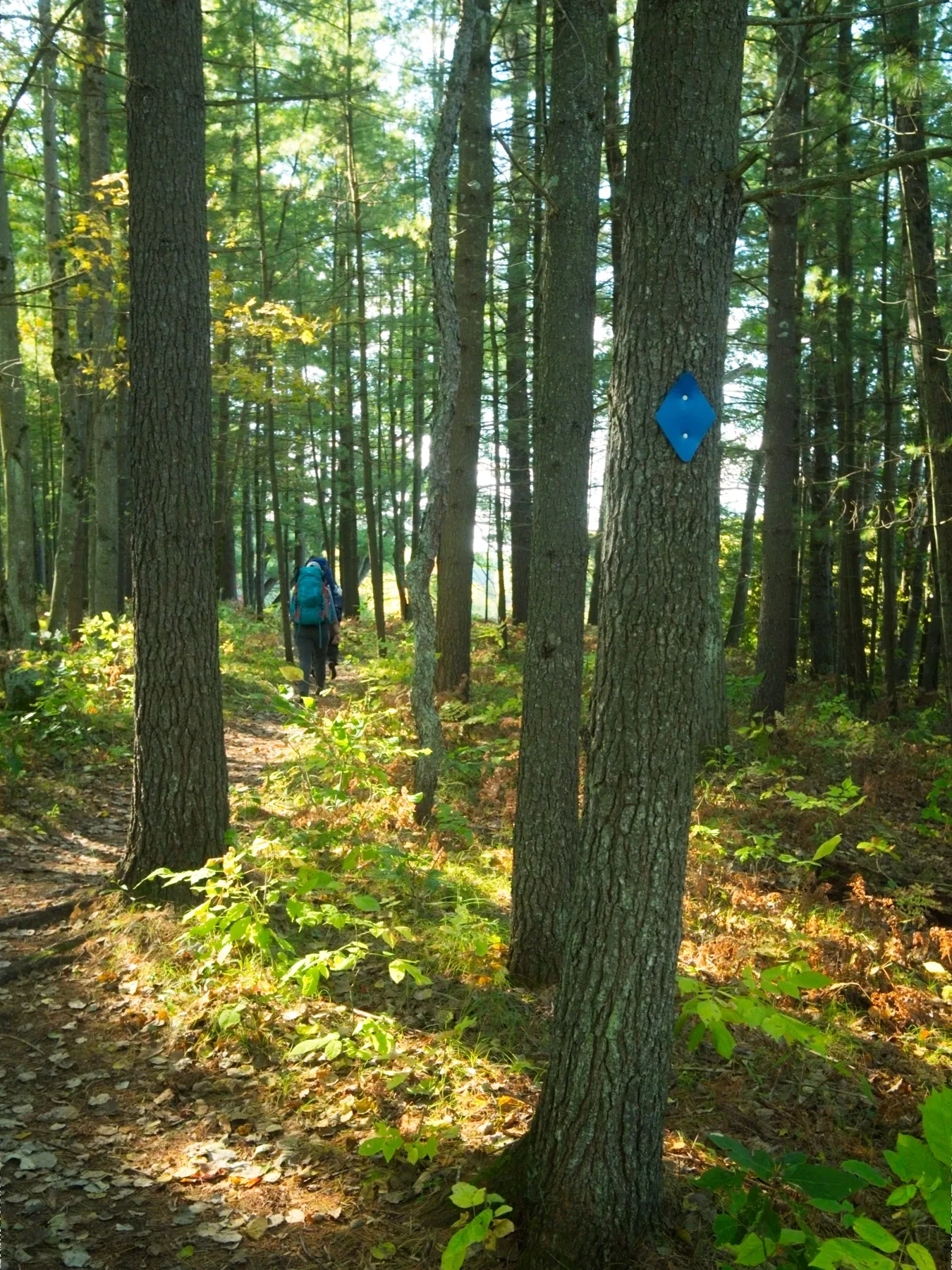 Blue diamond blaze marking the Manistee River TrailOne of the distinctive blue diamond blazes marking the Manistee River Trail.
Blue diamond blaze marking the Manistee River TrailOne of the distinctive blue diamond blazes marking the Manistee River Trail.
Emily gets up close and personal with a massive tree encountered on the trail.
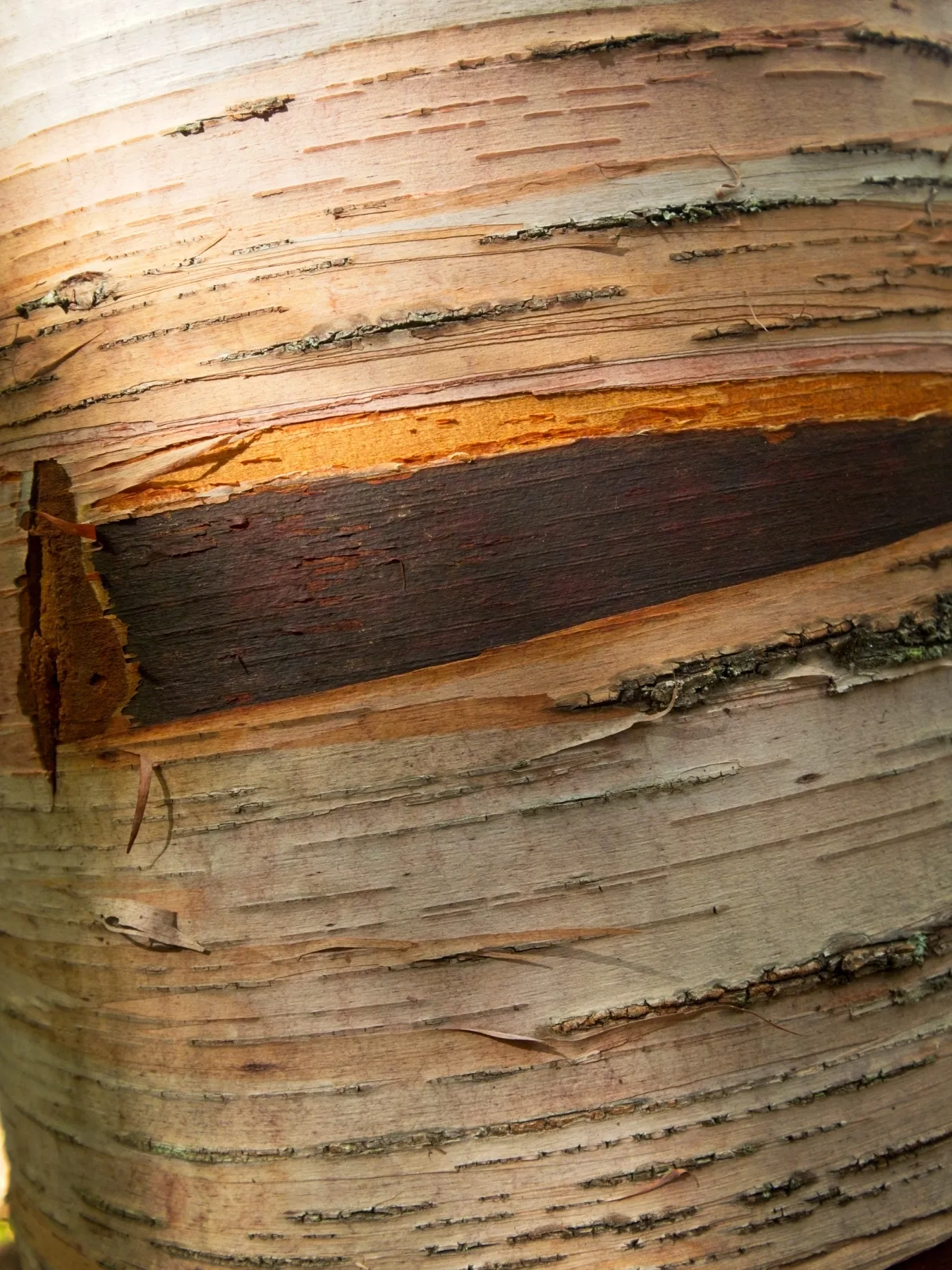 Close-up of the layered bark of a birch treeA close look at the layered bark of a birch tree, showing silver to dark red tones.
Close-up of the layered bark of a birch treeA close look at the layered bark of a birch tree, showing silver to dark red tones.
We took our time this morning, stopping frequently to admire the colorful trees, enjoy snacks, and simply soak in the beautiful weather. Mid-morning found us taking a longer break on the riverbank. Kenza cooled her feet in the river while Emily and I indulged in a sunny trail nap. I don’t recall ever taking a morning nap on a backpacking trip before, but it was incredibly pleasant.
Kenza soaks her feet in the river during a relaxing break.
A stand of golden trees across the river glows brilliantly in the sunlight.
Andrew and Emily enjoying a morning nap by the riverbank.
After our extended break, we continued strolling along the trail. Much of the remaining MRT section follows the ridge just above the Manistee River, offering several stunning views, particularly around the river’s characteristic 180-degree bends. When not on the ridge, the trail traverses shady groves closer to the shoreline. As we neared the end of the loop, the trail briefly left the river behind, crossing Slagle, Dead, and Cedar Creeks. A final gentle climb through a forest of tall pines brought us back to the Cottage Road parking area, where our car awaited, lightly dusted with fallen leaves.
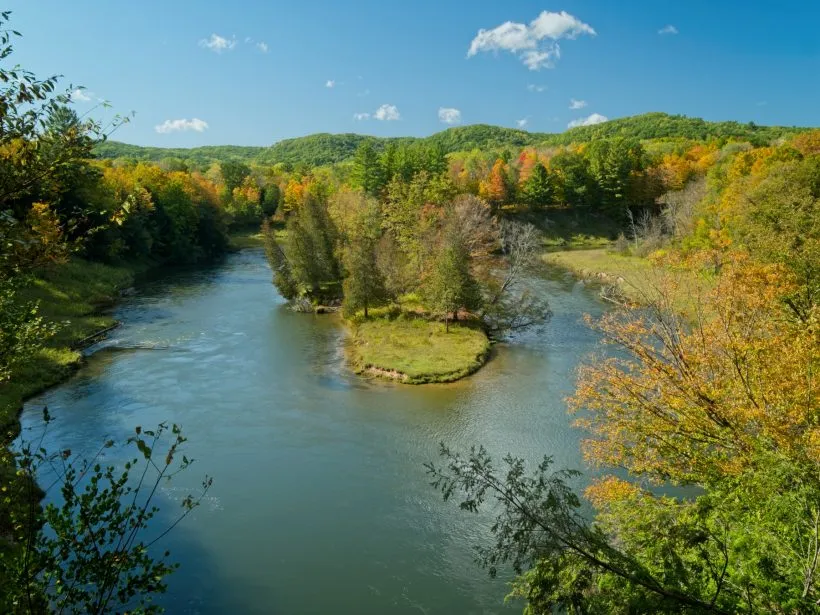 View overlooking another 180-degree bend in the Manistee RiverAnother iconic 180-degree bend in the Manistee River provides a spectacular view.
View overlooking another 180-degree bend in the Manistee RiverAnother iconic 180-degree bend in the Manistee River provides a spectacular view.
Tips for Backpacking in Manistee National Forest
Based on my experience on the Manistee River Trail loop, here are a few tips for anyone planning a trip:
Best Time to Visit
While beautiful year-round, autumn offers stunning fall foliage and pleasant temperatures, ideal for hiking. Be prepared for potentially cooler nights and variable weather, including rain, as experienced during our trip. Spring can bring higher water levels and potentially muddier trails, while summer offers warmer weather but also more bugs.
Water Sources
The Manistee River is the most reliable water source, especially on the MRT section. However, you’ll need a water filter or purification method. Water is less readily available along the ridge-top NCT section, so fill up at Red Bridge or a flowing creek before ascending.
Campsite Selection
The MRT offers designated (free, first-come, first-served) sites which are often scenic and well-spaced. Dispersed camping is an option throughout the forest, but be sure to choose a suitable location away from water and trails, minimizing your impact. Arriving earlier in the day, especially on weekends or during peak season (like fall color), will increase your chances of securing a prime spot.
What to Pack
Standard backpacking gear applies. Be sure to pack layers, as temperatures can change quickly, especially in fall. Rain gear is essential regardless of the forecast. Don’t forget your water filter or purification system.
Combine Your Trip: Exploring More of Michigan
While focused on backpacking in Manistee National Forest, this area is part of the larger Michigan experience. For ideas on other destinations and attractions, consider exploring the best places to visit in michigan to extend your adventure beyond the trail.
Conclusion: Your Manistee Backpacking Adventure Awaits
Backpacking in Manistee National Forest offers a wonderful opportunity to immerse yourself in Michigan’s natural beauty. The Manistee River Trail loop, combining the scenic riverside path with the higher ridge of the North Country Trail, provides a diverse and rewarding experience. It’s a perfect blend of accessibility and wildness, showcasing vibrant forests, gentle rivers, and peaceful solitude. Whether you’re seeking a weekend escape or are new to multi-day hiking, this loop is a fantastic option. So pack your bags, lace up your boots, and discover the tranquil paths and stunning vistas that await you on a backpacking adventure in Manistee National Forest.
